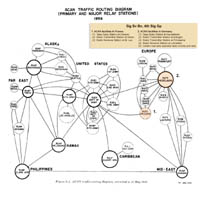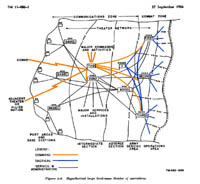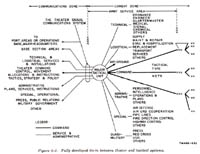If you do
NOT see the Table of Contents frame to the left of this page, then
Click here to open 'USArmyGermany'
frameset |
Army Command and Administrative Network
7774th Signal Service Battalion
Looking for more information from military/civilian
personnel assigned to or associated with the U.S. Army
in Germany from 1945 to 1989. If you have any
stories or thoughts on the subject, please contact me . .
|
|
|
|
|
|
| ACAN General Information |
| |
Fixed signal communications are defined broadly as all channels, circuits, and facilities employed for the transmission and reception of signals by electrical means to meet the communication requirements of the Department of the Army within, between, and among commands of the continental United States as well as oversea commands, bases, task forces, and separate commands.
A worldwide communications system (the Worldwide Network), consolidated under the sole command of the Joint Chiefs of Staff (Pentagon), is operated by the Army, Air Force and Navy to maintained contact between the major commands (CONUS and overseas) and the Pentagon.
The Worldwide Network serves all three of the armed services. Channels are allocated to each on a full-time basis, and other channels are made available to all the services on a common-user basis. |

ACAN 1956

ACAN and Tactical Systems
 ACAN - Tactical System Interface
ACAN - Tactical System Interface
|
The channels serving the Army form a distinct and separate entity called the Army Command and Administration Network (ACAN). Specifically, ACAN is the communication system employed for the transmission or reception of signals by electrical means, including telephone, teletypewriter, and facsimile, to meet the communication requirements of the Department of the Army within the CONUS, theater communication zones, oversea commands, task forces, bases, and separate commands, and between these elements.
ACAN is a direct responsibility of the Chief Signal Officer, who exercises operational and technical control over the network through the Army Communication Service Division of OCSigo.
ACAN is composed of several distinct and separate systems, all of which are mutually interconnected. Among the several systems are:
 (1) The CONUS System (1) The CONUS System
 (2) The Intercontinental System, which interconnects the CONUS system with other systems overseas (2) The Intercontinental System, which interconnects the CONUS system with other systems overseas
 (3) The Theater System, which is particular to a certain region within a theater of operations (3) The Theater System, which is particular to a certain region within a theater of operations
Thus, CINCUSAREUR in Heidelberg has instant access to the Department of the Army and other theater system through the European Theater System (operated by the 4th Signal Group) - as illustrated in the diagram on the left from 1956.
The Theater System
The ComZ is of particular interest because it is the territory within which the theater's fixed signal communication system is established and operated. This is one of the major systems for which the Army is responsible. It is called The Theater System.
 a. The Theater System is a part of ACAN and is is the fixed-signal communication system established and operated within the ComZ of a theater of operations. a. The Theater System is a part of ACAN and is is the fixed-signal communication system established and operated within the ComZ of a theater of operations.
 b. The Theater System connects with the Intercontinental System which is also a component of ACAN. Thus, through ACAN, The Theater System is interconnected with the CONUS and other theater systems. b. The Theater System connects with the Intercontinental System which is also a component of ACAN. Thus, through ACAN, The Theater System is interconnected with the CONUS and other theater systems.
|
|
 c. The Theater System connects with the several tactical systems that serve the field armies, corps, and divisions in the combat zone. These tactical systems, however, are not components of The Theater System. c. The Theater System connects with the several tactical systems that serve the field armies, corps, and divisions in the combat zone. These tactical systems, however, are not components of The Theater System.
 d. In principle, The Theater System extends as far forward as the army near boundary. This principle, however, is influenced by the military doctrine that a higher headquarters is always responsible for communications forward to the next subordinate command. In practice, therefore, The Theater System actually crosses the army rear boundary at many points and penetrates the combat zone as far forward as army group headquarters and, in many instances, army headquarters. d. In principle, The Theater System extends as far forward as the army near boundary. This principle, however, is influenced by the military doctrine that a higher headquarters is always responsible for communications forward to the next subordinate command. In practice, therefore, The Theater System actually crosses the army rear boundary at many points and penetrates the combat zone as far forward as army group headquarters and, in many instances, army headquarters.
 e. There is a tendency to believe that certain teletypewriter circuits extending as far forward as corps headquarters belong, or should belong, to The Theater System because the operations of these circuits is governed by the ACAN standing operating procedure (SOP). To accept this point of view is to suggest that The Theater System is defined in terms of the ACAN SOP. However, there is no authority for such a redefinition. e. There is a tendency to believe that certain teletypewriter circuits extending as far forward as corps headquarters belong, or should belong, to The Theater System because the operations of these circuits is governed by the ACAN standing operating procedure (SOP). To accept this point of view is to suggest that The Theater System is defined in terms of the ACAN SOP. However, there is no authority for such a redefinition. |
| |
Purposes of The Theater System
The Theater System provides channels for the two broad categories of command and administrative traffic, and normally both kinds of traffic pass through the same channels. From the point of view of operations, therefore, it is often difficult to distinguish between command and administrative channels. But for planning and engineering purposes this distinction must be drawn, and considerable importance attaches to it, for it compels the solution of certain problems in a way that considerations of efficiency alone would forbid. The situation, simply stated, is this:
 a. All administrative channels are planned and engineered on the basis of requirements, and these requirements are determined and justified by the findings of traffic engineers. But command channels are provided on the basis of military necessity, and without reference to the number of calls each day or the total volume of traffic passing over them. a. All administrative channels are planned and engineered on the basis of requirements, and these requirements are determined and justified by the findings of traffic engineers. But command channels are provided on the basis of military necessity, and without reference to the number of calls each day or the total volume of traffic passing over them.
 b. Command channels serve the all-important purposes of command, fire control, movement control, and operational support. These are the high-priority channels that implement all plans of strategy and tactics, fire-power and maneuver, and such administrative and supply action as may be required to bring decisive force to bear upon the enemy. b. Command channels serve the all-important purposes of command, fire control, movement control, and operational support. These are the high-priority channels that implement all plans of strategy and tactics, fire-power and maneuver, and such administrative and supply action as may be required to bring decisive force to bear upon the enemy.
 (1) Command channels for the most part serve activities located at or near command posts, and command posts are moved frequently. (1) Command channels for the most part serve activities located at or near command posts, and command posts are moved frequently.
 (2) Command channels must be instantly available. Therefore it is normally not possible to allocate these channels on a shared basis to serve any other purpose. (2) Command channels must be instantly available. Therefore it is normally not possible to allocate these channels on a shared basis to serve any other purpose.
 c. Administrative channels serve all supply, evacuation, and administrative activities in short, all activities in support of tactical operations. Normally, administrative channels are more numerous than command channels and require greater quantities of equipment and facilities, particularly in the army rear area and the ComZ. These channels normally connect points that are more or less remote from command posts. c. Administrative channels serve all supply, evacuation, and administrative activities in short, all activities in support of tactical operations. Normally, administrative channels are more numerous than command channels and require greater quantities of equipment and facilities, particularly in the army rear area and the ComZ. These channels normally connect points that are more or less remote from command posts.
 d. In spite of all that can be said about the differences between command and administrative traffic, it is nearly always necessary to integrate some of the command and administrative channels. A compelling need for such integration may arise from unforeseen demands or unavoidable shortages of equipment and supplies. The demand in each instance is for an essential service, and the aggregate of demands upon the signal officer often exceeds his signal resources. In such a case, the extent to which integration can be safely attempted is a question that demands careful judgment. d. In spite of all that can be said about the differences between command and administrative traffic, it is nearly always necessary to integrate some of the command and administrative channels. A compelling need for such integration may arise from unforeseen demands or unavoidable shortages of equipment and supplies. The demand in each instance is for an essential service, and the aggregate of demands upon the signal officer often exceeds his signal resources. In such a case, the extent to which integration can be safely attempted is a question that demands careful judgment. |
| |
| Work in progress |
 |
|
|
| ACAN in European Theater |
|
| ACAN in Germany |
| |
| |
| |
|
|
| ACAN in Italy |
| |
| (Source: STARS & STRIPES, May 3, 1960) |
Leghorn ACAN Station, 21st Signal Company
The 21st Signal Company at Camp Darby, Livorno (Leghorn) operates the Major Relay Station (RUFS) at Camp Darby. (Livorno is site of Headquarters, 8th Logistical Command.) This station, established in 1952 to support USFA in Austria, serves as a major relay link in the ACAN communications network that spans the world.
The Leghorn station is a relay link between two larger Primary Relay Stations, at Pirmasens in Germany and at Asmara in Eritrea. Communications is via teletype, voice radio and facsimile. As a major relay, the station at Camp Darby is responsible for passing messages to and from minor relays and to terminal stations. Everything traveling into or out of SETAF goes through the Leghorn station.
Five officers and 60 enlisted personnel work (in three shifts; 24-hour operation) at one of three facilities that make up the ACAN Station:
 Main station Main station
 Receiver Site Receiver Site
 Transmitter Site Transmitter Site
Main Station -- comprised of the facilities control section and the tape relay section.
Receiver Site -- is located five miles to the north of the main station.
Transmitter Site -- is located five miles to the south of the main station.
Messages are classified by precedence. From lowest to highest precedence:
 Deferred Deferred
 Routine Routine
 Priority Priority
 Operational Operational
 Immediate Immediate
 Emergency Emergency
 Flash Flash
A "flash" is rare but when it comes in, everything else stops until it has been processed.
Facilities ("FAX") Control Station -- this center provides control functions for its associated transmitter and receiver stations and teletypewriter facilities in, or associated with, the tape-relay networks.
Tape Relay Center -- this is were the message handlers work; the center employs the torn-tape system. |
 |
|
| |
Related Links:
|
| |
| |
|



